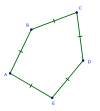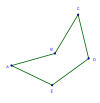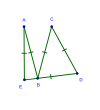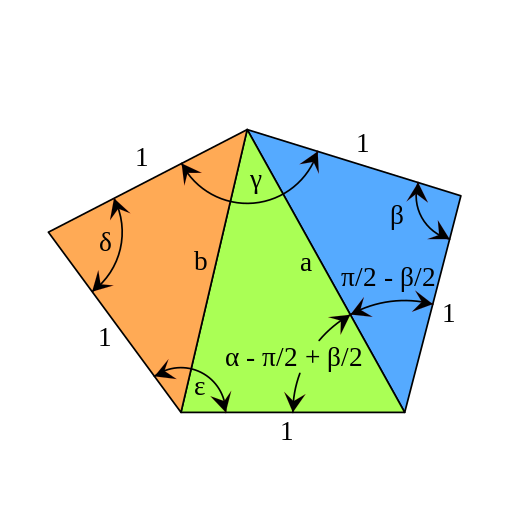In geometry an equilateral pentagon is a polygon with five sides of equal length. Its five internal angles, in turn, can take a range of sets of values, thus permitting it to form a family of pentagons. The requirement is that all angles must add up to 540 degrees and must be between 0 and 360 degrees but not equal to 180 degrees. In contrast, the regular pentagon is unique, because it is equilateral and moreover it is equiangular (its five angles are equal; the measure is 108 degrees).
Four intersecting equal circles arranged in a closed chain are sufficient to determine a convex equilateral pentagon. Each circle's center is one of four vertices of the pentagon. The remaining vertex is determined by one of the intersection points of the first and the last circle of the chain.
Equilateral pentagon built with four equal circles disposed in a chain.
It is possible to describe the five angles of any convex equilateral pentagon with only two angles α and β, provided α ≥ β and δ is the smallest of the other angles. Thus the general equilateral pentagon can be regarded as a bivariate function f(α, β) where the rest of the angles can be obtained by using trigonometric relations. The equilateral pentagon described in this manner will be unique up to a rotation in the plane.
Examples
 Regular pentagon |
 Regular star pentagram |
 Adjacent right angles |
 Convex |
 Self-intersecting |
 Concave |
 Degenerate into triangle (colinear edges) |
 Degenerate (edge-vertex overlap) |
 Degenerate into trapezoid (colinear edges) |
Internal angles
Equilateral Pentagon dissected into 3 triangles which helps to calculate the value of angle δ as a function of α and β.
When the equilateral pentagon is dissected into triangles, two of them appear as isosceles (triangles in orange and blue) while the other one is more general (triangle in green). We assume that we are given the adjacent angles α {\displaystyle \alpha } \alpha and β {\displaystyle \beta } \beta .
According to the law of sines the length of the line dividing the green and blue triangles is:
\( {\displaystyle a=2\sin \left({\frac {\beta }{2}}\right).} \)
The square of the length of the line dividing the orange and green triangles is:
\( {\displaystyle {\begin{aligned}b^{2}&=1+a^{2}-2(1)(a)\cos \left(\alpha -{\frac {\pi }{2}}+{\frac {\beta }{2}}\right)\\&=1+4\sin ^{2}\left({\frac {\beta }{2}}\right)-4\sin \left({\frac {\beta }{2}}\right)\sin \left(\alpha +{\frac {\beta }{2}}\right).\\\end{aligned}}} \)
According to the law of cosines, the cosine of δ can be seen from the figure:
\( \cos(\delta )={\frac {1^{2}+1^{2}-b^{2}}{2(1)(1)}}\ .\)
Simplifying, δ is obtained as function of α and β:
\( {\displaystyle \delta =\arccos \left[\cos(\alpha )+\cos(\beta )-\cos(\alpha +\beta )-{\frac {1}{2}}\right].} \)
The remaining angles of the pentagon can be found geometrically: The remaining angles of the orange and blue triangles are readily found by noting that two angles of an isosceles triangle are equal while all three angles sum to 180°. Then ϵ , γ , {\displaystyle \epsilon ,\gamma ,} {\displaystyle \epsilon ,\gamma ,} and the two remaining angles of the green triangle can be found from four equations stating that the sum of the angles of the pentagon is 540°, the sum of the angles of the green triangle is 180°, the angle γ {\displaystyle \gamma } \gamma is the sum of its three components, and the angle ϵ {\displaystyle \epsilon } \epsilon is the sum of its two components.
A cyclic pentagon is equiangular if and only if it has equal sides and thus is regular. Likewise, a tangential pentagon is equilateral if and only if it has equal angles and thus is regular.[1]
Two-dimensional mapping
All the equilateral pentagons plotted within the area delimited by the condition α ≥ β ≥ δ. Three regions for each of three types of pentagons are shown: stellated, concave and convex
The equilateral pentagon as a function of two variables can be plotted in the two-dimensional plane. Each pair of values (α, β) maps to a single point of the plane and also maps to a single pentagon.
The periodicity of the values of α and β and the condition α ≥ β ≥ δ permit the size of the mapping to be limited. In the plane with coordinate axes α and β, α = β is a line dividing the plane in two parts (south border shown in orange in the drawing). δ = β as a curve divides the plane into different sections (north border shown in blue).
Both borders enclose a continuous region of the plane whose points map to unique equilateral pentagons. Points outside the region just map to repeated pentagons—that is, pentagons that when rotated or reflected can match others already described. Pentagons that map exactly onto those borders have a line of symmetry.
Inside the region of unique mappings there are three types of pentagons: stellated, concave and convex, separated by new borders.
Stellated
The stellated pentagons have sides intersected by others. A common example of this type of pentagon is the pentagram. A condition for a pentagon to be stellated, or self-intersecting, is to have 2α + β ≤ 180°. So, in the mapping, the line 2α + β = 180° (shown in orange at the north) is the border between the regions of stellated and non-stellated pentagons. Pentagons which map exactly to this border have a vertex touching another side.
Concave
The concave pentagons are non-stellated pentagons having at least one angle greater than 180°. The first angle which opens wider than 180° is γ, so γ = 180° (border shown in green at right) is a curve which is the border of the regions of concave pentagons and others, called convex. Pentagons which map exactly to this border have at least two consecutive sides appearing as a double length side, which resembles a pentagon degenerated to a quadrilateral.
Convex
The convex pentagons have all of their five angles smaller than 180° and no sides intersecting others. A common example of this type of pentagon is the regular pentagon.
References
De Villiers, Michael, "Equiangular cyclic and equilateral circumscribed polygons", Mathematical Gazette 95, March 2011, 102-107.
Undergraduate Texts in Mathematics
Graduate Studies in Mathematics
Hellenica World - Scientific Library
Retrieved from "http://en.wikipedia.org/"
All text is available under the terms of the GNU Free Documentation License




